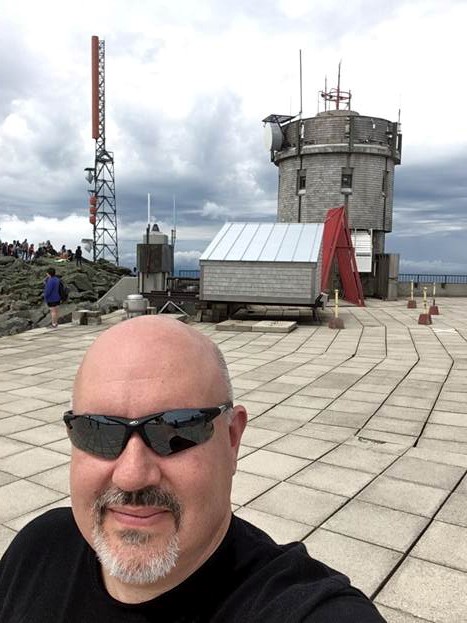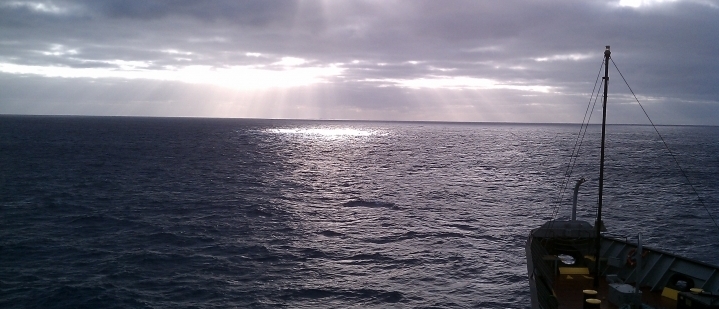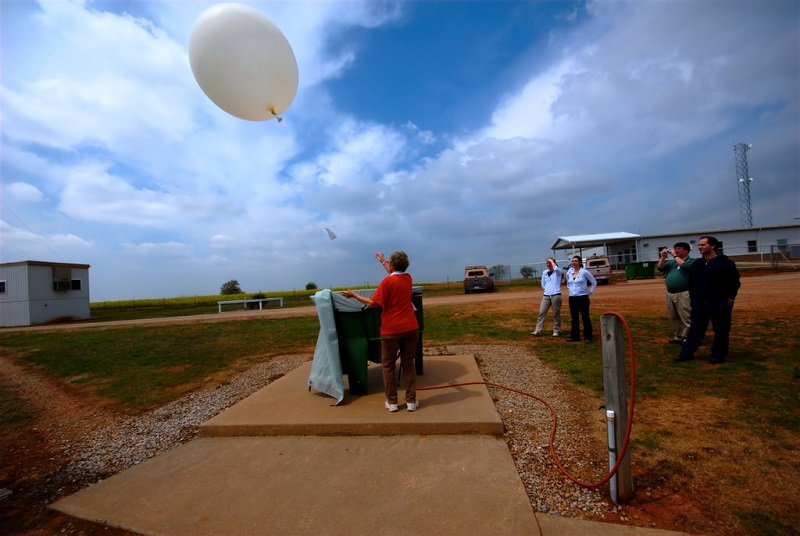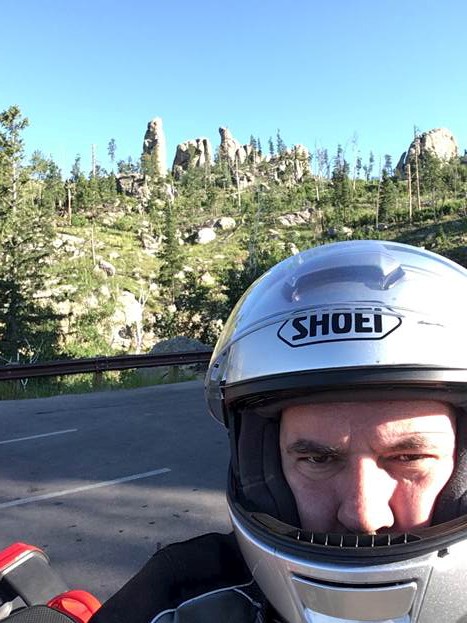Boss of the Boundary Layer
Published: 20 April 2020
David Mechem’s early interests in computers and weather brought on a cloud-modeling career
This is the latest article in a series of profiles on scientists who use ARM data.

The American Midwest is where David Mechem―atmospheric scientist, modeler, and University of Kansas professor―makes his home. His research interests, however, often bend oceanward to the vast fields of marine boundary-layer clouds that gather off the coast of California, South America, and Africa.
These diverse gatherings of marine stratocumulus and shallow cumulus clouds are found within the lowest two kilometers (1.24 miles) above the Earth. Because they are so bright, these clouds scatter enough solar radiation back into space that they exert a strong net cooling effect on the planet.
Shallow clouds help humidify the lower atmosphere by transporting moisture and energy upward and promoting the transition to deeper precipitation cloud systems. They are as bright and light-reflecting as stratocumulus, but they cover smaller areas and in more scattered formations―in puffs instead of thick decks.
Mechem is researching challenges in the way boundary-layer clouds are represented in the global climate models. For example, he says, models struggle with the timing of how shallow cumulus clouds transition to deeper cloud types that result in precipitation.
Key data for his research are provided by the U.S. Department of Energy’s (DOE) Atmospheric Radiation Measurement (ARM) user facility, which maintains three fixed and three portable observatories in climate-critical regions of the world.
Entrainment Uncertainties
Mechem and his team of graduate students are particularly interested in one facet of the dynamics of boundary-layer clouds: entrainment.
This mixing process describes the movement of warm air into clouds from above and the sides. In the case of shallow cumulus, models estimate how turbulence patterns above and around these puffy clouds blend dry air from outside the cloud into the cloud itself.
Meanwhile, entrainment uncertainties can have consequences for shallow clouds in models.
One pathway to more answers is a 2016–2020 project led by Mechem and funded by DOE’s Atmospheric System Research (ASR) program.
Global climate models simulate conditions within grids 50 kilometers by 50 kilometers (31 miles by 31 miles) on each side, he says. “But this entrainment mixing happens on a much smaller scale. We have to understand how to represent it.”
One might think of clouds as self-contained entities, but in reality, they exist within an environment of air influences, says Mechem. “Clouds are basically air currents made visible.”
‘A Fabulous Data Set’

At least seven papers have emerged from the ASR entrainment project. Mechem is “particularly proud” of two.
A 2019 paper quantifies entrainment estimates of marine stratocumulus clouds, a task so exceptionally difficult that Mechem calls it a “holy grail” for cloud researchers. Its lead author is Virendra Ghate, an ASR research veteran from Argonne National Laboratory in Illinois. Mechem is a co-author.
The study is based on data from ARM’s 2012–2013 Marine ARM GPCI Investigation of Clouds (MAGIC). During the MAGIC field campaign, instruments were mounted on a cargo ship repeatedly traversing the Pacific Ocean.
“It’s a fabulous data set,” says Mechem. “But the ship was sampling a soda-straw vertical profile from a moving platform, which makes the analysis challenging.”
Confronting Cloud Transitions

A second “really cool” paper, says Mechem, was published in 2018 and co-authored by Mechem and researcher Scott Giangrande of Brookhaven National Laboratory in New York.
The study confronted the enigma of how shallow cumulus clouds transition to the deeper cloud types, such as cumulus congestus, which may produce rain. Tied in was the need to understand what controls the onset of precipitation.
The co-authors focused on a single day during the Midlatitude Continental Convective Clouds Experiment (MC3E): May 25, 2011. MC3E took place from April to June 2011 at ARM’s Southern Great Plains (SGP) atmospheric observatory, which spans parts of Oklahoma and Kansas.
Broadly, MC3E was an attempt to get a holistic three-dimensional (3D) data picture of how clouds, winds, and moisture intersect to produce convective clouds―those that signal thunderstorms and rain.
To investigate the transition of cloud types leading up to precipitation, Mechem and Giangrande used a suite of 16 large-eddy simulations―a way to mathematically model boundary-layer clouds. In-cloud buoyancy turned out to be a key factor signaling the transition to deeper precipitating clouds.
Models are what Mechem does, but he says the MC3E paper showed that “you can only (find such answers) by combining observations and modeling.”
Entrainment’s General Physical Laws
“I have made a conscious decision to work with a lot of observationalists.”
David Mechem, University of Kansas atmospheric scientist and modeler
Historically, most modeling studies of entrainment are based on a few different marine environments. But Mechem has also researched continental locales, using data from both MC3E at the SGP and ARM’s Green Ocean Amazon (GoAmazon2014/15) field campaign in the rainforests of Brazil.
“Ideally, what we’re after are general physical laws on how entrainment works,” says Mechem.
For a second ASR project, however, he has turned his research eyes back to marine boundary-layer clouds. He is a co-investigator on a project looking at how cloud microphysical properties influence, at small scales, the initiation of warm rain.
The principal investigator was Zhibo Zhang of the University of Maryland, Baltimore County. The two will combine models with data from the 2017–2018 Aerosol and Cloud Experiments in the Eastern North Atlantic (ACE-ENA) field campaign. Its nexus was ARM’s ENA atmospheric observatory on Graciosa Island in the Azores.
Wherever they take him, entrainment studies are a natural part of Mechem’s general research interests, which involve looking into the physical mechanisms of clouds and precipitation processes.
“Modeling is my intellectual home, in some sense,” he says. “But I have made an effort to reach out to DOE labs. I have made a conscious decision to work with a lot of observationalists. Thus, all these collaborations.”
In the future, Mechem wants to investigate “really interesting cloud-clearing events off the coast of Africa,” he says. “Huge regions of low clouds (at night) are being scoured out by some event originating on the continent,” possibly some form of internal gravity waves being excited by the daily land-sea breeze.
Storms, Stars, and Computers

Mechem grew up in Oklahoma City, where “severe storms are part of life and part of culture,” he says.
During his boyhood, Mechem also had an attraction to computers and a passion for astronomy.
His father, a bookkeeper, may have established some impulse towards order and record-keeping that fed into Mechem’s later professional attraction to modeling and mathematics.
His mother, a medical technologist, “had very broad scientific training,” including in chemistry and microbiology, says Mechem.
At any rate, he says, “both of them were very encouraging with my scientific exploits growing up.”
With the benefit of “cherished” physics and math teachers at Putnam City High School, Mechem describes wrapping up his secondary school time with a year of independent study in linear algebra and statistics.
He was a meteorology major and mathematics minor at the University of Oklahoma (B.S., 1993), where he supplemented his summa cum laude performance with four years as a technician at the National Severe Storms Laboratory. The laboratory, which has a partnership with the university, is a research arm of the National Oceanic and Atmospheric Administration.
He worked there under veteran meteorologist Carl E. Hane, who was his supervisor, his undergraduate research advisor, and his research-methods mentor.
“I had always wanted to do some kind of physical science,” says Mechem of his undergraduate years. “I also got an interest in the modeling point of view.”
PhD Influences

In 1993, with his strong inclination to be a modeler still intact, Mechem started doctoral studies in atmospheric sciences at the University of Washington (PhD, 2003), where he studied with Robert A. Houze Jr.
That relationship drew Mechem into the data world of the Tropical Ocean-Global Atmosphere (TOGA) Coupled Ocean Atmosphere Response Experiment (COARE) in the Western Pacific Ocean.
Co-advised by Houze and professor Shuyi Chen (then a postdoctoral researcher), Mechem wrote a dissertation related to one feature of tropical convection: the huge channels of convective air inflow, both deep and shallow, that showed up on radar images of deep convective clouds.
Mechem’s PhD studies were a little fragmented. He was in Seattle from 1993 to 1998 for coursework, advisement, and a start on writing his dissertation. He returned to the University of Oklahoma in 1998 as a research associate, finished his dissertation while working, and then took on the role of a research scientist.
It was at Oklahoma that Mechem did his first work on boundary-layer clouds with cloud-microphysics expert Yefim Kogan.
In 2007, Mechem moved to the University of Kansas (KU). Today, he and his wife, Elizabeth, have three daughters: one at KU and two still in high school.
Teaching duties take up a substantial fraction of Mechem’s time.
“Teaching helps me focus on making good arguments and on arguments that are easy to understand,” he says.
Mechem occasionally offers a course in severe and unusual weather, which attracts non-majors and gives him a chance to pitch science and logical thinking.
“It’s a fun class to teach,” he says. “I’m still a weather weenie and storm-nut kind of guy―though my own research is pretty far from all that.”
Biking, Baking, Bass Guitar Playing

A glimpse at Mechem’s Twitter-page description sums up his eccentrically complicated life: KU Atmospheric science professor, motorcycles, electric bass, baking, bicycling, F1, Moby Dick enthusiast, Oxford comma now and forever.
“There are so many interesting things out there to do,” he says.
Back in his Seattle graduate school days, Mechem met his wife while playing bass guitar “in a crappy rock/power pop band,” he says. (She played keyboards.) Grunge was just beginning to fade.
Mechem is an avid sport-touring motorcyclist and has wheeled through Kansas, the Dakotas, northwest Arkansas, and most of New England.
“I like bicycling too, but that’s a lot more work,” he says. “It’s an adrenaline versus endorphins thing.”
“F1” means Formula One―the single-seat and super-fast car racing that debuted in France 70 years ago.
Moby Dick? Mechem is a fan of the 1851 American novel about whaling by Herman Melville and named all his lab computers after the book’s ships.
He is also a fan of the Oxford comma, which calls for a final comma in any list of things. “It’s strangely controversial for some reason,” says Mechem.
Oh, and baking: That’s his favorite part of time in the kitchen. For this story, he shared images of a peach caramel upside-down cake and a coconut cream pie.
“When all gets said and done,” says Mechem, “I’ll be remembered as an OK scientist, but a really exceptional baker. That will go on my tombstone.”
Keep up with the Atmospheric Observer
Updates on ARM news, events, and opportunities delivered to your inbox
ARM User Profile
ARM welcomes users from all institutions and nations. A free ARM user account is needed to access ARM data.


















